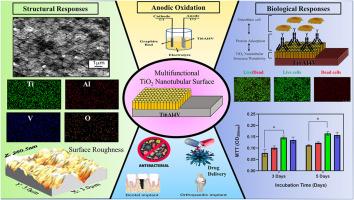Ti6Al4V植入表面制备TiO2纳米管的表面特性及生物学评价
IF 3.9
2区 材料科学
Q2 MATERIALS SCIENCE, MULTIDISCIPLINARY
引用次数: 0
摘要
本研究的重点是在Ti6Al4V表面上创建TiO2(二氧化钛)高度有序的纳米管阵列,以提高其在生物医学应用中的表面粗糙度,抗菌活性和生物相容性。该方法在由乙二醇、NH4F和超纯水组成的有机浴液中进行阳极氧化过程。在恒电压30 V下,阳极氧化时间分别为3 h、4 h和5 h,抛光后Ti6Al4V、TiO2 30 V 3 h、TiO2 30 V 4 h和TiO2 30 V 5 h的表面粗糙度分别为2.77 nm、16.92 nm、19.75 nm和22.01 nm。氧化后的样品在生长24 h后,对枯草芽孢杆菌和大肠杆菌的抑菌效果进行早期定量评估。通过MTT和粘附实验研究了细胞在不同表面上的活力,发现晶体纳米管改善了体外反应。总的来说,这项工作证明了使用多功能TiO2纳米管在抗生素膜、抗菌和增强骨整合方面提供协同影响的重要性。本文章由计算机程序翻译,如有差异,请以英文原文为准。

Surface characteristics and biological evaluation of TiO2 nanotubes fabricated on Ti6Al4V implant surface
The significant focus of this research was to create the TiO2 (Titanium dioxide) highly ordered nanotube arrays on a Ti6Al4V surface to improve surface roughness, antibacterial activity and biocompatibility for its use in biomedical applications. In this approach, the anodic oxidation process was carried out in the organic bath solution, which is composed of ethylene glycol, NH4F, and ultrapure water. The process was carried out at a constant voltage of 30 V under different anodic oxidation time durations of 3 h, 4 h, and 5 h. The surface roughness of the polished Ti6Al4V, TiO2 30 V 3 h, TiO2 30 V 4 h, and TiO2 30 V 5 h are 2.77 nm, 16.92 nm, 19.75 nm, and 22.01 nm respectively. The early-stage assessment of the antimicrobial efficacy of oxidized specimens was conducted quantitatively against Bacillus subtilis and Escherichia coli after a 24 h period of growth. The cell viability on different surfaces was investigated by MTT and adhesion assays, which revealed improved in vitro response to the crystalline nanotubes. Overall, this work demonstrates the importance of using multifunctional TiO2 nanotubes to provide a synergistic impact on antibiofilm, antibacterial, and enhanced osseointegration.
求助全文
通过发布文献求助,成功后即可免费获取论文全文。
去求助
来源期刊

Vacuum
工程技术-材料科学:综合
CiteScore
6.80
自引率
17.50%
发文量
0
审稿时长
34 days
期刊介绍:
Vacuum is an international rapid publications journal with a focus on short communication. All papers are peer-reviewed, with the review process for short communication geared towards very fast turnaround times. The journal also published full research papers, thematic issues and selected papers from leading conferences.
A report in Vacuum should represent a major advance in an area that involves a controlled environment at pressures of one atmosphere or below.
The scope of the journal includes:
1. Vacuum; original developments in vacuum pumping and instrumentation, vacuum measurement, vacuum gas dynamics, gas-surface interactions, surface treatment for UHV applications and low outgassing, vacuum melting, sintering, and vacuum metrology. Technology and solutions for large-scale facilities (e.g., particle accelerators and fusion devices). New instrumentation ( e.g., detectors and electron microscopes).
2. Plasma science; advances in PVD, CVD, plasma-assisted CVD, ion sources, deposition processes and analysis.
3. Surface science; surface engineering, surface chemistry, surface analysis, crystal growth, ion-surface interactions and etching, nanometer-scale processing, surface modification.
4. Materials science; novel functional or structural materials. Metals, ceramics, and polymers. Experiments, simulations, and modelling for understanding structure-property relationships. Thin films and coatings. Nanostructures and ion implantation.
 求助内容:
求助内容: 应助结果提醒方式:
应助结果提醒方式:


